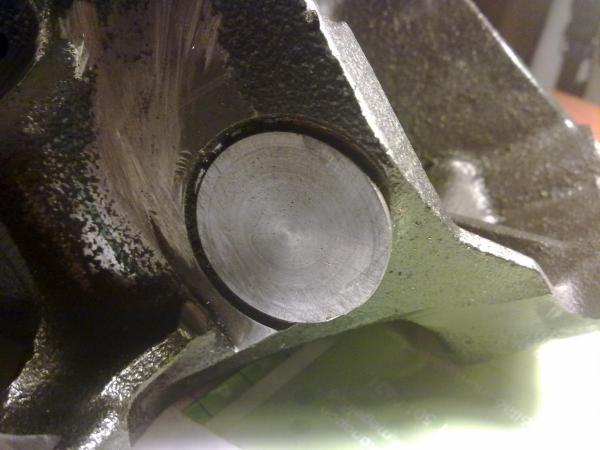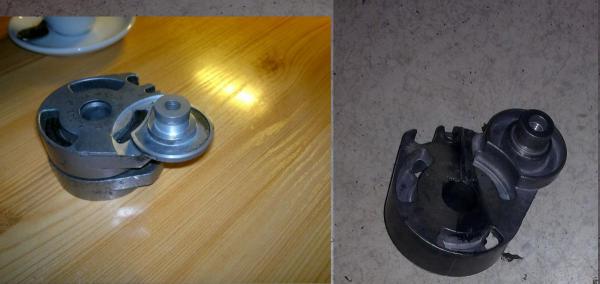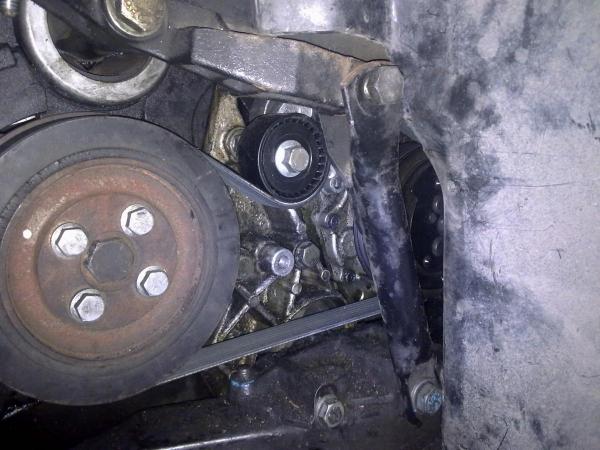2.5 turbo diesel aux belt tensioner
The jockey arm type auxiliary belt tensioner is no longer available from Citroën. If yours starts to rattle, warning of an impending failure, you only have the option to modify it. There are two possible ways to do it: either fix it permanently or use a replacement tensioner with the necessary modifications to fit it.
The fixed solution is much simpler but it has the inherent problem of being fixed. Citroën changed from an earlier fixed arrangement to a spring damped one for a reason. If anything (road debris, pebble, any small object) gets behind the belt accidentally, the belt will snap immediately, rendering the car motionless and to be trailered (the auxiliary belt drives both the HP pump and the alternator). A spring loaded tensioner will yield in the same situation and the belt will survive.
If you decide for this second solution, here is a working example. The part we found as the appropriate candidate was the tensioner of Peugeot 206 1.4 HDI engines of around year 2004 (part number: 9638380780):

Needless to say, this pulley is not a drop-in replacement. The original mounting bracket needs to be modified so that the tensioner can be fitted and, optionally, the tensioner itself can be modified, although this second operation is not absolutely necessary.
You can mount the tensioner and use a narrower, 5K1680 belt that runs in an acceptable but not optimally centered position. It will work all right but you should expect a shorter belt lifetime, maybe 20% less than optimal. Or you can modify the tensioner to achieve a perfect fit, running a 6K1680 belt in the optimal position.
Mounting bracket
The mounting bracket can be worked on in situ, although it's certainly easier with it off the engine; but this requires the removal of quite a few extra parts. In my case it was unavoidable to remove it because the thread of the original jockey arm mounting hole was beyond repair. Thus, the pictures show the bracket separated from the engine.
The hole and recess where the arm was fitted have to be plugged with a suitable (or machined) plug:

This plug is not only screwed into the original hole but also fixed with Diamant Ultrametal cold welding adhesive. The bracket surface around the plug has been filed to get rid of protrusions.
A threaded steel sleeve provides the fixing position for the new tensioner (threading an M8 hole into the cast iron itself wouldn't be strong enough):

Positioning the mounting hole requires the use of the actual tensioner assembly as a template. You have to find the position that allows the swinging part to stay clear of the vertical protrusions of the bracket, as can be seen from the green pen marks on the picture:

Again, the sleeve is glued with Ultrametal.
This is the finished bracket, imperfections and grooves filled with Ultrametal and filed to a smooth, even surface. As usual, it looks rather ugly but in reality it's quite all right.

In my case, it was possible to do the filing because the bracket had been removed. If it's done with the bracket in situ, the imperfections can be filled with Ultrametal, covered with aluminium foil and pressed down with the tensioner itself to form the surface.
Tensioner pulley
Now you can decide whether you take the short or the long route. You can attach the original Peugeot tensioner as is, and use a 5K1680 belt. Or you can remove some extra metal to make the pully come significantly closer to the engine, completely in line with everything else around there.
First, remove as much material as you dare from the bottom side of the tensioner. This picture will not reveal too much but the bottom isn't as thick as it used to be:

Second, and here comes the really tricky bit: you have to machine the pulley shaft to retain its form but to become much shorter. I hope this picture is clear enough (after and before):

After all this work, the assembly is straightforward. The belt in this case is a 6K1680, perfect fit in every way:

Note that the belt is routed differently than before (hence the significant change in its length). The new route follows the modified route Citroën later adopted on contemporary engines. Instead of going to the eccentric tensioner after the hydraulic pump and then going on to the alternator, the path now is: HP pump, alternator, eccentric, A/C. This reduces the bottom lash of the belt drastically.